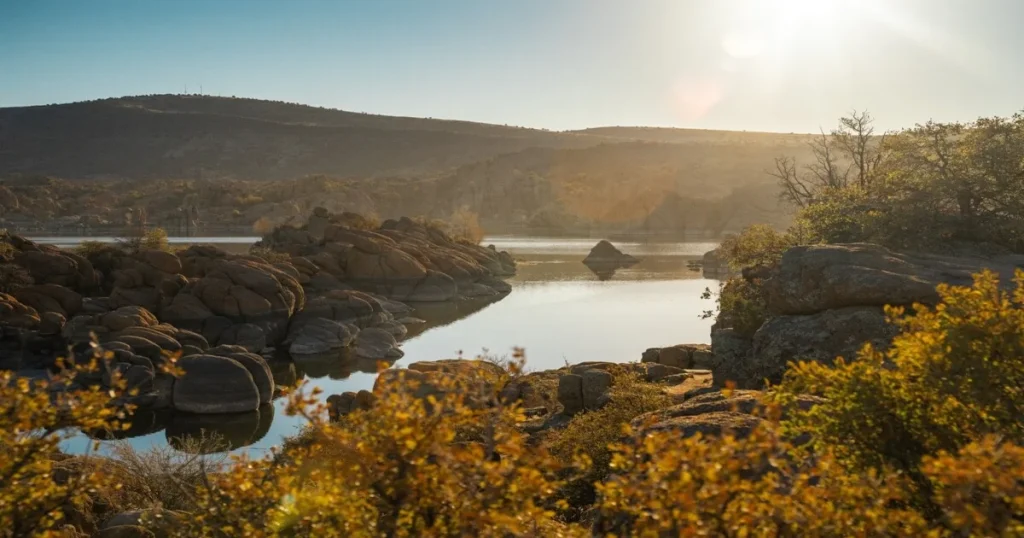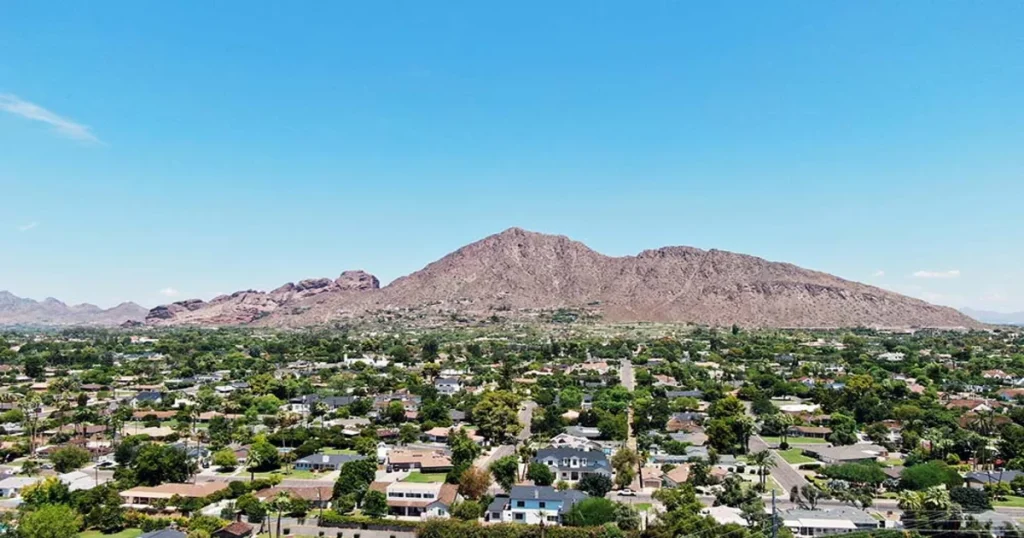Arizona is a land of climatic extremes and scenic diversity. From arid deserts to lush forests, the state’s topography is as varied as the climatic conditions it houses. Given this diversity, it’s natural for each city to have its own unique climate.

The focus of this article is on the comparison of Prescott’s climate with other Arizona cities. Understanding local climates can be pivotal for residents, tourists, and anyone contemplating a move to the Grand Canyon State. So, let’s dive in and uncover what sets Prescott apart and how it compares with other significant cities in Arizona.
The Geography of Arizona: A Quick Primer
Before jumping into the nitty-gritty details of Arizona’s climate, it’s crucial to understand the role of geography. The state’s climate is not just a result of its latitude but also its varied elevation levels and geographical features. From the Colorado Plateau to the Sonoran Desert, Arizona’s terrain greatly impacts its weather patterns.
The state’s geography is so varied that you can go from a sunny, arid desert to a snowy mountain range in a matter of hours. This not only makes Arizona a fascinating place for tourists but also means that its residents have a host of climate options to choose from, all within the state’s borders.
The Climate of Prescott: An Overview
Prescott, often referred to as “Everybody’s Hometown,” is nestled at an elevation of 5,368 feet above sea level. The city has a semi-arid climate, making it quite different from the stereotypical, arid Arizona desert.
Contrary to the sweltering heat found in many Arizona cities, Prescott experiences relatively moderate temperatures year-round, making it a popular destination for those looking to escape the harsh desert climate. Geographical factors, like the surrounding Bradshaw Mountains, also contribute to the area’s pleasant weather.
Temperature in Prescott: A Seasonal Analysis
Prescott’s temperature is moderate compared to many other Arizona cities. The summer highs usually reach the 80s or low 90s (Fahrenheit), while winter lows can dip to around freezing but rarely go below that. According to the National Weather Service, these temperature ranges are considered mild compared to other parts of Arizona.
As for its seasonal changes, Prescott’s temperature variation isn’t as stark as that of Phoenix or Tucson. However, it does experience all four seasons, which isn’t the case for many other parts of Arizona. This makes Prescott an appealing option for those who want to experience a range of climatic conditions without the extremes.
Precipitation in Prescott
When it comes to precipitation, Prescott stands out with its more balanced yearly rainfall. The city receives about 19 inches of rain per year, which is significantly more than what Phoenix or Tucson get.
Snowfall is another interesting aspect. While Prescott does get snow, it’s usually modest compared to cities like Flagstaff. On average, Prescott receives about 12.8 inches of snow per year, according to U.S. Climate Data. This makes the city a good choice for those who enjoy a little winter wonder but don’t want to be snowed in for months.
Air Quality in Prescott
Air quality is a major consideration for many people, especially those with respiratory issues. Fortunately, Prescott generally boasts good air quality. The Air Quality Index often shows Prescott as having “Good” to “Moderate” air quality.

Moreover, the natural landscapes around Prescott contribute to the clean air. The surrounding forests and the absence of heavy industry mean the area is less polluted than more metropolitan Arizona cities. This is a significant selling point for anyone concerned about environmental factors when choosing a place to live.
Comparing Prescott with Phoenix
Phoenix, the capital of Arizona, is the epitome of a hot desert climate. With summer temperatures regularly exceeding 100°F, it’s a stark contrast to Prescott’s moderate climate.
Despite being only a two-hour drive apart, Prescott and Phoenix could not be more different in terms of climate. While Phoenix experiences over 100 days of temperatures exceeding 100°F, Prescott rarely, if ever, reaches those figures. This, in part, explains why many Phoenix residents flock to Prescott during the summer months to escape the heat.
Why Do People Choose Prescott over Phoenix?
While both cities have their charm, many choose Prescott over Phoenix for several reasons:
- Cooler summer temperatures
- Fewer days with extreme heat
- Better air quality
Lifestyle factors also play a role. Prescott offers a small-town vibe with the benefits of a larger city, such as healthcare facilities and shopping centers. In contrast, Phoenix provides all the amenities of a bustling metropolitan area but at the cost of higher temperatures and lower air quality, according to the Arizona Department of Environmental Quality.
Comparing Prescott with Tucson
Tucson, another large city in Arizona, also has a hot desert climate but is generally a bit cooler than Phoenix. Tucson’s average summer high is in the mid-90s, which is still significantly hotter than Prescott.
Tucson experiences its own monsoon season, with heavy but brief rainfall in the summer. This is in contrast to Prescott, which receives more evenly distributed rainfall throughout the year. Thus, while Tucson residents may get a reprieve from the heat during the monsoon season, they still experience more temperature extremes than Prescott residents.
Is Tucson a Viable Alternative to Prescott?
Tucson and Prescott both offer outdoor recreational opportunities and similar lifestyle choices. However, Tucson is more suitable for those who prefer a larger city with a more robust arts scene and a broader range of cultural events.
Climatically speaking, Tucson can be a good alternative to Prescott if you can handle higher temperatures and enjoy a more dramatic monsoon season. However, for those seeking milder conditions throughout the year, Prescott might be the better choice, especially given its air quality and more evenly distributed precipitation.
Comparing Prescott with Flagstaff
Flagstaff is another Arizona city that breaks the state’s stereotype of being hot and dry year-round. Located at an elevation of about 7,000 feet, Flagstaff experiences cold winters and mild summers.
The most distinct difference between Flagstaff and Prescott is the snowfall. Flagstaff is one of the snowiest cities in the United States, receiving an average of over 100 inches of snow annually, as per The Weather Channel. This is in sharp contrast to Prescott’s modest annual snowfall, making Flagstaff a haven for winter sports enthusiasts but potentially challenging for those not fond of heavy snow.
Recreational Opportunities Influenced by Climate
Prescott and Flagstaff both offer an array of outdoor activities, but the type of activities is highly dependent on the climate. In Flagstaff, you can engage in skiing, snowboarding, and other winter sports, thanks to its snowy winters.
Prescott, on the other hand, offers a more moderate climate suitable for year-round outdoor activities. You can go hiking, mountain biking, or simply enjoy a day out by the lakes. The choice between the two cities largely depends on your preference for seasonal recreational opportunities.
Comparing Prescott with Sedona
Sedona, famous for its red rock formations and spiritual vortexes, has a climate that sits somewhere between that of Prescott and Phoenix. While Sedona is generally warmer than Prescott, it’s cooler than Phoenix, making it an attractive middle-ground option for some.
Sedona experiences hot summers but not to the extremes seen in Phoenix. Winter temperatures are milder compared to Prescott and especially Flagstaff. It’s a climate that allows for outdoor activities nearly year-round but does reach a level of heat in the summer that some might find uncomfortable.
The Tourism Angle: Prescott vs. Sedona
Both Sedona and Prescott are tourist magnets, but they attract different kinds of visitors, thanks in part to their respective climates. Sedona is often considered a spiritual haven where the climate allows for year-round hiking and exploring, as noted by the Official Tourism Bureau of Sedona.
Prescott, with its cooler summers and milder winters, attracts those looking for an escape from the more extreme climates of other Arizona cities. It’s particularly popular among retirees and young families who prefer a balanced climate to engage in a variety of activities throughout the year.
Comparing Prescott with Scottsdale
Scottsdale, located closer to Phoenix, mimics the capital city’s desert climate but usually registers slightly cooler temperatures. However, it still experiences the classic Arizona heat, especially in the summer months.
Scottsdale’s climate is one of its defining features, attracting tourists and retirees alike who are in search of hot, dry conditions. However, it’s worth noting that this kind of weather can be challenging for those not accustomed to such heat, especially when compared to the more moderate conditions in Prescott.
The Comfort Index: Scottsdale or Prescott?

When it comes to comfort indices, which consider factors like temperature, humidity, and general weather conditions, Prescott often scores higher than Scottsdale. These scores are important for potential residents and tourists who are sensitive to extreme weather conditions.
While Scottsdale might offer more in terms of luxury resorts and high-end amenities, Prescott wins when it comes to a comfortable, year-round climate. This makes Prescott an attractive option for those who want to experience Arizona’s beauty without enduring its harsher climatic extremes.
The Overall Picture: Climate Comparison Table
To put everything into perspective, let’s consider a summarizing table that outlines key climate statistics for each city discussed:
- Prescott: Moderate temperatures, balanced precipitation, good air quality
- Phoenix: Hot and dry, limited precipitation, lower air quality
- Tucson: Hot but less so than Phoenix, monsoon season, moderate air quality
- Flagstaff: Cold winters, mild summers, heavy snowfall
- Sedona: Hot summers, milder winters, moderate precipitation
- Scottsdale: Similar to Phoenix but slightly cooler, with limited precipitation
This table aims to give you a snapshot of how Prescott compares with other Arizona cities in terms of climate. Each city has its own pros and cons, making Arizona a fascinating state to explore, whether you’re visiting or considering a move.
Frequently Asked Questions: Comparison of Prescott’s climate with other Arizona cities
What makes Prescott’s climate unique among Arizona cities?
Prescott’s climate stands out for its moderation. Unlike other cities that experience extreme temperatures, Prescott enjoys a balanced climate, making it ideal for year-round outdoor activities.
Is Prescott’s climate suitable for retirees?
Absolutely. The moderate climate, combined with good air quality, makes Prescott a popular choice among retirees.
How does Prescott’s air quality compare to other Arizona cities?
Prescott generally has better air quality compared to larger cities like Phoenix and Tucson, thanks to its geographical features and absence of heavy industry.
What are the economic implications of these climate differences?
Climate can significantly impact sectors like tourism, real estate, and healthcare. For instance, Prescott’s moderate climate makes it a popular destination, boosting local businesses and property values.
Summary
Arizona is a state of climatic diversity, offering a range of options from the extreme heat of Phoenix to the snowy conditions in Flagstaff. Nestled among these variances is Prescott, a city that offers a moderate, semi-arid climate that is proving to be increasingly attractive for both residents and tourists alike.
Whether it’s the temperate summers, the mild but present winter season, or the good air quality, Prescott holds its own when compared to other Arizona cities. In the grand tapestry of Arizona’s climates, Prescott serves as a balanced thread, weaving its own unique pattern that many find irresistibly charming.



Leave a Comment
You must be logged in to post a comment.